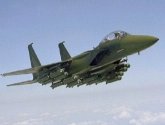
 The F-15E is an air superiority
tactical fighter that is totally integrated for air-to-air and
deep interdiction missions. With the recent retirement of the
F-111, the F-15E has become the USAF's premier deep strike/interdiction
aircraft. The original F-15
design has come a long way from its role as an interceptor. While
externally it may look similar to a mere two-seat Eagle, the
F-15E is very much its own aircraft. Born out of a desire to
replace the F-111, the Air Force looked towards a private venture
created by McDonnell Douglas to create a strike version of their
air superiority fighter. The idea was to create a fighter-bomber
which could conduct its strike mission with a minimum of support
and without the need for accompaniment by escort fighters. While
the original prototype, dubbed the "Strike Eagle" was
a modified F-15B, today's F-15E is a different aircraft both
inside and out. While still retaining its air-superiority characteristics,
the F-15E can carry aloft a heavier payload than its predecessors
and deliver it greater distances. It is quite a change from the
"not a pound for air-to-ground" motto that heralded
the Eagle's introduction. The F-15E was the unsung hero of Desert
Storm. The aircraft logged approximately 7,700 combat hours in
the air during the conflict, with each of the two squadrons present
in the theater flying some 1,200 missions. F-15Es were among
the first aircraft to lead the strike against Iraq during the
opening night of the war, and appeared over the skies of Baghdad.
From that initial attack, they struck at strategic targets such
as communication facilities, key bridges, and command & control
facilities deep in the heart of Iraq. F-15Es were key players
at night in the hunt for SCUD missiles in the desert near the
Jordanian border as they worked closely with E-8 JSTARS aircraft
who searched the desert-floor for launchers and storage units.
Due to the F-15E's precision-strike capability, it could carry
the fight to the enemy both day and night. In addition to these
types of sorties, F-15Es also took part in tactical strikes against
tanks in the Kuwaiti Theater of Operations. Armed with laser-guided
GBU-10s, F-15Es routinely assisted A-10s in missions dubbed "tank-plinking".
Again, the F-15E was able to carry out such operations 24 hours
a day. Throughout the entire campaign, the F-15E's displayed
stellar performance. Perhaps the only thing keeping this aircraft
from stardom in the Gulf was the introductory presence of the
F-117. This was essentially the debut of stealth for most of
the world and as a result, the "Wobbly Goblin" captured
the spotlight due to its novelty. However, the true "bomb
trucks" of the USAF were the F-111s and the F-15Es.
The F-15E is an air superiority
tactical fighter that is totally integrated for air-to-air and
deep interdiction missions. With the recent retirement of the
F-111, the F-15E has become the USAF's premier deep strike/interdiction
aircraft. The original F-15
design has come a long way from its role as an interceptor. While
externally it may look similar to a mere two-seat Eagle, the
F-15E is very much its own aircraft. Born out of a desire to
replace the F-111, the Air Force looked towards a private venture
created by McDonnell Douglas to create a strike version of their
air superiority fighter. The idea was to create a fighter-bomber
which could conduct its strike mission with a minimum of support
and without the need for accompaniment by escort fighters. While
the original prototype, dubbed the "Strike Eagle" was
a modified F-15B, today's F-15E is a different aircraft both
inside and out. While still retaining its air-superiority characteristics,
the F-15E can carry aloft a heavier payload than its predecessors
and deliver it greater distances. It is quite a change from the
"not a pound for air-to-ground" motto that heralded
the Eagle's introduction. The F-15E was the unsung hero of Desert
Storm. The aircraft logged approximately 7,700 combat hours in
the air during the conflict, with each of the two squadrons present
in the theater flying some 1,200 missions. F-15Es were among
the first aircraft to lead the strike against Iraq during the
opening night of the war, and appeared over the skies of Baghdad.
From that initial attack, they struck at strategic targets such
as communication facilities, key bridges, and command & control
facilities deep in the heart of Iraq. F-15Es were key players
at night in the hunt for SCUD missiles in the desert near the
Jordanian border as they worked closely with E-8 JSTARS aircraft
who searched the desert-floor for launchers and storage units.
Due to the F-15E's precision-strike capability, it could carry
the fight to the enemy both day and night. In addition to these
types of sorties, F-15Es also took part in tactical strikes against
tanks in the Kuwaiti Theater of Operations. Armed with laser-guided
GBU-10s, F-15Es routinely assisted A-10s in missions dubbed "tank-plinking".
Again, the F-15E was able to carry out such operations 24 hours
a day. Throughout the entire campaign, the F-15E's displayed
stellar performance. Perhaps the only thing keeping this aircraft
from stardom in the Gulf was the introductory presence of the
F-117. This was essentially the debut of stealth for most of
the world and as a result, the "Wobbly Goblin" captured
the spotlight due to its novelty. However, the true "bomb
trucks" of the USAF were the F-111s and the F-15Es.
Nation of Orgin: USA
Constructor: McDonnell Douglas
Type: dual-role strike/attack and air-superiority fighter
Crew: 2
Wingspan: 42 feet 9 3/4 inches
Length: 63 feet 9 inches
Height: 18 feet 5 1/2 inches
Wing Area: 608 square feet.
Weight: 31,700 pounds
Maximum t-o weight: 81,000 pounds
Engine: Two Pratt & Whitney F100-PW-229 turbofans, thrust
13154kg (29,000lb) each
Max. speed: Mach 2.54 (1676 mph)
Climb Rate: 50,000ft/min
Ceiling: 65,000ft
Range: 2765 miles
Armament: One 20-mm M61A1 Vulcan six-barrel cannon with 512 rounds;
24,500 pounds including AIM-9L/M Sidewinder, AIM-7F/M Sparrow,
AIM-120 AMRAAM, AGM-65 Maverick, JDAM, Mk 20 Rockeye, Laserguided
bombs, Free Fall Bombs and B61 nuclear weapons